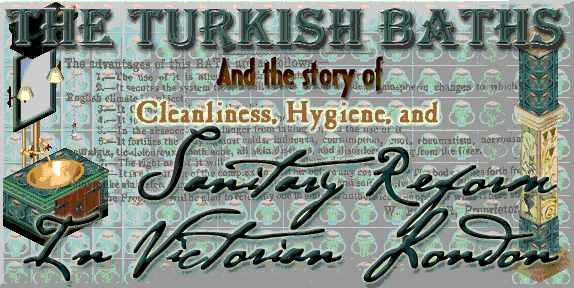
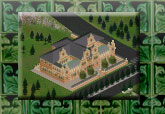 This page is devoted to a particular style of bathroom / bathing which you could adapt to any of your houses. As well as the obvious Victorian, I have been shown that the pieces look particularly good in Goth or pseudo-Gothic houses, and can work well under a Mediaeval surrounding as well. I have even seen some screenshots of them being used in an ultra-mod-pod loft with all the other rooms having white & grey walls, floors and accessories - the colours stood out like a jewelry box in a snowstorm and surprised even me as to how well it went together.
This page is devoted to a particular style of bathroom / bathing which you could adapt to any of your houses. As well as the obvious Victorian, I have been shown that the pieces look particularly good in Goth or pseudo-Gothic houses, and can work well under a Mediaeval surrounding as well. I have even seen some screenshots of them being used in an ultra-mod-pod loft with all the other rooms having white & grey walls, floors and accessories - the colours stood out like a jewelry box in a snowstorm and surprised even me as to how well it went together.
All of the objects have been improved or modified in some way from the original set (which remains at TSR) and many of these are hacked objects with many grateful thanks to C&C Enterprises' Cybergrape & Cambouisfr - or is it the other way around? :o)
 The images of ceramic tiles are from combinations of photographs taken by me in various situations or scanned from one of the many tile catalogues I have accumulated over the years, all brought together to evoke the Victorian ceramic style. Although I have arranged the objects in three styles - the Victorian Gentleman's Bath, the Victorian Ladies' Bath and the Municipal Baths - all of these objects (except the gender-specific doors) can be used by any sim, I have just decorated them in styles appropriate to the Gentleman's and Ladies' rooms of the time period.
The images of ceramic tiles are from combinations of photographs taken by me in various situations or scanned from one of the many tile catalogues I have accumulated over the years, all brought together to evoke the Victorian ceramic style. Although I have arranged the objects in three styles - the Victorian Gentleman's Bath, the Victorian Ladies' Bath and the Municipal Baths - all of these objects (except the gender-specific doors) can be used by any sim, I have just decorated them in styles appropriate to the Gentleman's and Ladies' rooms of the time period.
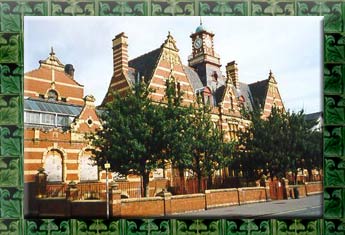 The house is loosely based on the Victoria Baths, Manchester, England, and I was inspired to do this after watching the Victoria Baths Trust win £3.38million towards the cost of restoring the building by coming in first place in the first of BBC2's "Restoration" reality TV architectural series, polling 280,018 votes in the final on Sunday 14th September 2003. One of those votes was, naturally, mine - although I did cheat and voted for a couple other favourites of mine as well. So many architectural treasures to choose from and I wanted to help them all!
The house is loosely based on the Victoria Baths, Manchester, England, and I was inspired to do this after watching the Victoria Baths Trust win £3.38million towards the cost of restoring the building by coming in first place in the first of BBC2's "Restoration" reality TV architectural series, polling 280,018 votes in the final on Sunday 14th September 2003. One of those votes was, naturally, mine - although I did cheat and voted for a couple other favourites of mine as well. So many architectural treasures to choose from and I wanted to help them all!
I have also reproduced some Victorian accounts here concerning sanitation and bathing - some of which make astonishing reading considering this is still so very recent history - as well as hopefully providing you with some nice things for your sims.
Finally, some historical & anecdotal information and images here are presented with very grateful thanks to Malcolm Shifrin and his Victorian Turkish Bath Databank, the gloriously named website The Victorian Crapper, and of course I am extremely grateful to the people of the official Manchester Victoria Baths website. The rest was done from notes taken from many and various sources including online, many library & personal books and general visits to The Museum of London at the Barbican.
To anyone who has ever read any of the works of Charles Dickens, his descriptions of Victorian London are lurid in the extreme. Compare these two passages concerning an area of London called "Jacob's Island" a moment:
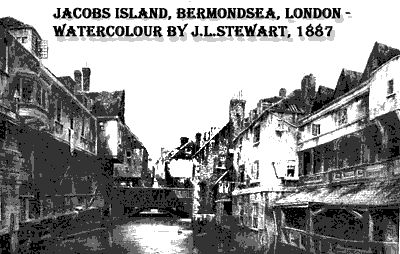 [Jacob's Island has rickety] "..wooden galleries from which to look upon the slime beneath; windows, broken and patched, with poles thrust out, on which to dry the linen that is never there; rooms so small, so filthy, so confined that the air would seem too tainted even for the dirt and squalor which they shelter; wooden chambers thrusting themselves out above the mud and threatening to fall into it - as some have done; dirt-besmeared walls and decaying foundations; every repulsive lineament of poverty, every loathsome indication of filth, rot, and garbage - all these ornament the banks of Folly Ditch".
[Jacob's Island has rickety] "..wooden galleries from which to look upon the slime beneath; windows, broken and patched, with poles thrust out, on which to dry the linen that is never there; rooms so small, so filthy, so confined that the air would seem too tainted even for the dirt and squalor which they shelter; wooden chambers thrusting themselves out above the mud and threatening to fall into it - as some have done; dirt-besmeared walls and decaying foundations; every repulsive lineament of poverty, every loathsome indication of filth, rot, and garbage - all these ornament the banks of Folly Ditch".
"In Jacob's Island may be seen at any time of day women dipping water, with pails attached by ropes to the backs of houses, from a foul, fetid ditch, its banks coated with a compound of mud, excrement and filth, and with offal and carrion - the water to be used for every purpose, culinary ones not excepted"
The first is a quote from Charles Dickens' "Oliver Twist" - but shockingly, the second is not Dickens - or even fiction - at all. It is actually from a contemporary eyewitness report detailing the findings of a survey of the area for a paper on the state of the environment of the poor. The Sanitary Reformers of Victorian times did more to ensure the way we live today than any other group of people, and this page goes on to give part of the story of Sanitary Reform in Victorian London.
The Victoria Baths, Manchester
The Victoria Baths - "a handsome structure of red Ruabon brick and terracotta built in the Renaissance style" - were designed as a prestigious baths complex by Manchester Corporation's Baths and Wash-houses Committee in 1903-6 to the design of the City Architect, Henry Price.
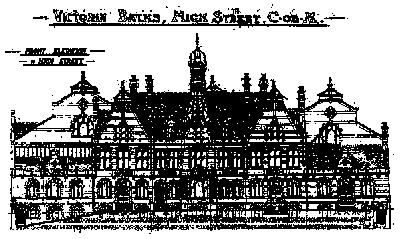
In their design and construction no expense was spared. As well as the splendid facade, the main interior public spaces are clad in glazed tiles from floor to ceiling and most of the many windows contain elaborate, beautiful, and unique stained glass.
For 86 years the Victoria Baths provided both essential and leisure facilities. Private baths and a laundry were housed there along with three swimming pools and the Turkish Baths.
The main swimming pool was floored over in the winter months to hold dances. In 1952 the Victoria Baths installed the first public Aerotone (jacuzzi) in the country.
The baths were closed in 1993 despite a vigorous public campaign which, though unsuccessful in stopping the closure, led to the formation of the Friends of Victoria Baths and the Victoria Baths Trust, both of which continue to campaign for the re-opening of the baths as part of a Healthy Living Centre for Central Manchester. The building is now in very poor repair and yet remarkably intact with most of the stained glass and original tiling remaining.
The Victoria Baths was a huge building. As well as the 3 swimming pools, it also housed 64 wash-baths, Turkish and Russian Baths, clubrooms, boilers & calorifiers as well as a laundry block and other outbuildings, and a substantial 4 bedroomed flat for the Superintendent of the Baths & Wash-Houses.
The laundry block was built to wash the towels used by swimmers and Turkish Baths customers, but when nearby public laundries closed, the Victoria Baths laundry was used as a public wash house. Women would bring their washing piled on prams and chat over the big sinks, driers and ironing tables.
From 1906 to 1993 the Victoria Baths provided the residents of Central Manchester with a wide range of facilities. At the time of opening, few of the houses in the area had bathrooms, so the slipper baths or wash baths were an important amenity, providing a "real bath" for many people.
The Victoria Baths were built with three distinct sections - Males 1st Class, Males 2nd Class and Females. Each class of user had their own entrance, swimming pool and slipper baths. Mixed bathing was introduced with great caution in 1914 and by the 1920's mixed bathing sessions were held every Sunday morning in the 1st Class Pool. This enabled families to swim together for the first time.
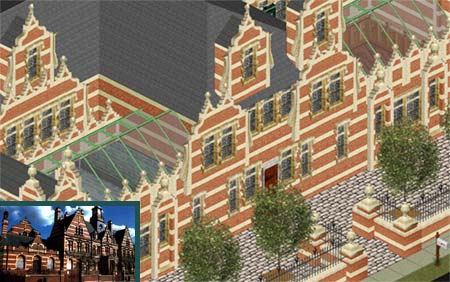
 The Victoria Baths - Lot 6
The Victoria Baths - Lot 6
Minor Update 2015: One of the gender doors (the gents') was installed backward. This has been fixed. This fix only effects those using the newly updated gender doors (see below for details).
PLEASE NOTE: This zip does not contain any objects, walls or floors. You will need to download, unzip and install all the object, wall & floor zips from below before playing this house, otherwise you will get the dreaded "missing objects" box and the house will be incomplete.
There is no shopping list for this house - all the pieces it is furnished with are found below or in the original game, with the exception of the Hacked Sycamore tree and the Sectional Wisteria which you should get from the Landscaping page, and Caro's invisible floor and the roof from the Brunel theme page.
Updates and Changes in 2015
All of the following zip files (including the laundry add-ons) have been updated. In many of the objects the only change has been the removal of unused BMPs (reducing the entire set by 3MB. WOOHOO!), the addition of a working thumbanil, and categorization for all lot types. Any fixes and additional changes to individual files are noted below.
 The Victoria Baths set 1
The Victoria Baths set 1
Two exterior walls, two interior walls, four opaque stained glass windows (one featuring an original design of The Angel of Purity from the Victoria Baths).
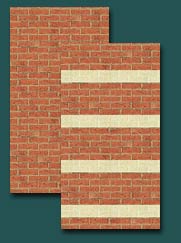
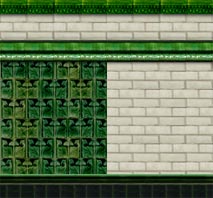

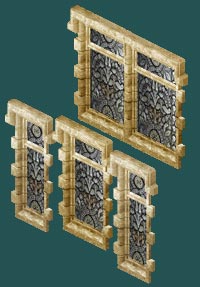
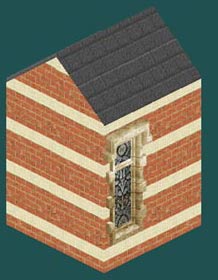
 The Victoria Baths set 2
The Victoria Baths set 2
Gable pieces (large size only required) - one with false window and one plain; three sectional Gable End pieces.
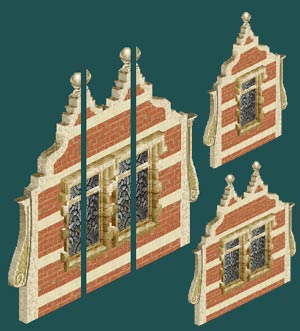
Thanks to the awesome talent of Cooptwin The Amazing And Magnificent, the gable pieces are droppable - you won't see them when played with walls cutaway or down and will remain in place when the house is sold. See more of Cooptwin's work at Another #%*& Sim Site
The Gable End pieces feature false windows and are based on a droppable rug piece. The centre piece is optional - you can add it or not, or add as many or as few as you like. You can place real windows behind these pieces and they shouldn't bleed through (none that I tested did anyway).
Because they are wider than one tile I don't recommend using them in an inner corner. They are backless and droppable with thanks to Koromo at Persimmon Grove, without whom I simply would not have anything unique to add to this site. Priced at the astonishingly low bargain basement price of just one simolean, you will find them in Buy Mode / Miscellaneous / General.
To place them on a second floor, you will need to place them on the transparent floor tile from Caro's Sim Kagen and included in my Brunel Set - with grateful thanks for permission to include it. You will also find the normal roof .bmp file for this house in the Brunel Set as I used the same one.
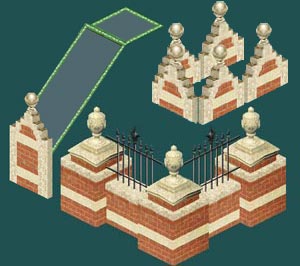
 The Victoria Baths set 3
The Victoria Baths set 3
Connecting fence, two part sectional glass roof kit, mock low wall.
Updated 2015: The larger section of glass roof has also been made droppable and fixed the flickering in both glass roof pieces. This was caused by a change in the game's rendering starting with the Unleashed expansion. The fix, however, may cause the semi-transparent glass to become opaque in earlier (pre-UL) versions of the game. If you find your are having that trouble, the original files should be installed in those games instead.
Original "Glass roof" idea and the base one (droppable) & two tiled rug objects by Koromo at Persimmon Grove, The low wall is based on the cloneable one-tiled rug from Sim Freaks & modified from the original mock fence idea by STP Carly at the Sims Tattoo Parlour.
In Victorian times, keeping clean was hard work. Working people who lived in the country usually had to fetch their drinking water from the village pump and collect rain water for washing in a water butt. Laundry was an arduous task, taking a whole day and much physical strength. The clothes had to be scrubbed with soap by hand or agitated in a basic hand-driven machine, soaked, rinsed several times, boiled, starched, blued or bleached, wrung, then hung up to dry and ironed.
Mrs Julia McNair Wright implies in her 1879 book "The Complete Home: An Encyclopedia of Domestic Life & Affairs" that the laundry was such a burden clothes were often left dirty for weeks at a time.
From "Some Habits and Customs of the Working Class", by Thomas Wright, 1867
By the time they [the working men] have finished relaxing with their pipes [on a Saturday half-holiday] it is probably two o'clock, and they then proceed to clean themselves up - that phrase being equivalent among "the great unwashed" to the society one of performing your toilet. The first part of the cleaning-up process consists in "a good wash", and it is completed by an entire change of dress. A favourite plan of cleaning-up on Saturday afternoons is - among those who live within easy reach of public baths - to take their clean suits to the bath, and put them on after they have bathed, bringing away their working suits tied up in a bundle. Some of the higher-paid mechanics present a very different appearance when cleaned up from that which they presented an hour or two before, when we saw them sauntering out of the factory gates.
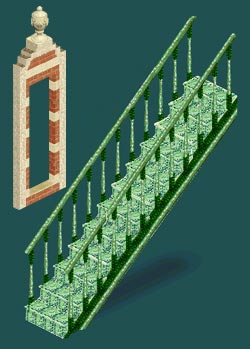
 The Victoria Baths set 4 (patched)
The Victoria Baths set 4 (patched)
Staircase, window pediment.
2015 Update: The stairs have been patched by Raeven (The Secret Society of Woobsha) with gno's "2-way" stairs hack, allowing multiple Sims to use the stairs at one time.
The window pediment is based on the droppable one-tile rug base by Koromo at Persimmon Grove, and is backless.
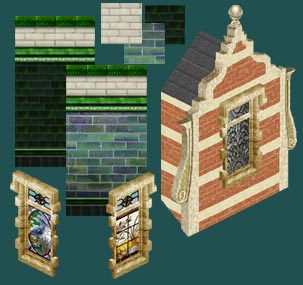
 The Victoria Baths set 5
The Victoria Baths set 5
Two interior walls, three floors, two opaque stained glass windows, mock third floor kit (two pieces).
The third floor gable kit is designed to sit above a second floor and show through the roof to give the impression of a third floor on the building. It is droppable, and your sims will happily walk over the pieces without noticing they are there. They are marked in the catalogue as "HIGH roof piece", and have been cloned on Koromo's droppable one tile rug object so you won't see them when the game is played with walls cutaway or down.
The Victorian Ladies' Bath
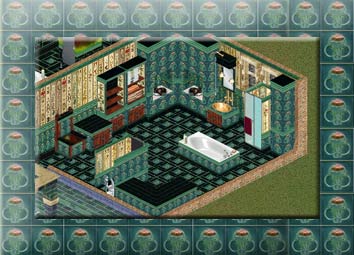
Water was piped into towns and many terraced or factory owned houses had a communal water supply at the end of each street. Some factory owners built houses for their workers which had a cold water tap in their kitchen - but no plumbing for disposal of waste water.
These kitchens were very basic indeed. General cooking was done on an open fire in a small cast iron range. Only the larger, wealthier houses had an oven built into the range; instead, at the end of most streets was a bakehouse or communal ovens, some of which were still used in living memory (again, my mother remembers taking the family bread & other bakery products down to the bakehouse as a child).
Bathing in the house was done in a portable tin tub by an open fire, with the water heated on the range in kettles.
Wealthier people would have had a bathroom in their house known as a "lavatory" (from the Latin lavatorium, from lavare, "to wash"). The room would have typically contained a large tub sometimes known as a "slipper bath" for bathing, and jugs of water & bowls would be set on a wash stand in each dressing room for washing hands and faces. However, indoor plumbing did not arrive until the 1880s so these would have been filled and emptied by the servants. "Privies" or "Necessaries" (non-flush toilets) were outside in an enclosed yard, with a chamber pot under the bed for night-time convenience.
While we are defining word origins, let me also deal with the word "toilet". When we read period novels such as those by Jane Austen, they often say that someone was at their toilet. Following the sniggers of perhaps millions of schoolchildren through the years, their exasperated literature teachers then have to explain that they were simply having a wash. This usage (first used 1695) comes from the Middle French toilette (diminutive of toile, "cloth") and meant either a cloth which was put over the shoulders while dressing the hair or shaving, or a cloth on which washing and shaving equipment was laid out. Over the years, the word gradually became a euphemism for the entire bathroom, then as it is today for just the waste cistern itself.
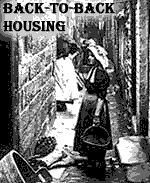
I grew up in a town which had been pivotal during the Industrial Revolution, and my own childhood house had its own enclosed back yard with its original privy which thankfully had been converted to a flush toilet in the 1940s when full indoor plumbing had also been introduced to the street. The houses in the streets closer to the factories only had one privy per five houses in a communal back yard, and some of the last remaining back-to-back houses (finally demolished in the 1970s) only had one privy at the end of each narrow lane of ten houses backing on to each other. The picture on the right is of the front of some similar houses, as they were built with no yards but backed on to each other with just a narrow lane separating the fronts.
Privies had a very basic sort of plumbing where you took a bucket of water (used, naturally) which you poured down the privy after use, taking the content down pipes leading to a nearby pit called a cesspool. Some types used sieved earth rather than water.
Growing concern at unsanitary conditions coupled with the British Victorian trend for philanthropic public building and growing obsession with hygiene led to the creation of the Baths & Washhouses Act (1846) which empowered local authorities to build swimming baths, slipper baths, and wash houses for the poor in the larger towns and cities, with one clean towel for each bather. These were soon known as "Turkish" baths, of which some still survive today, and were all architecturally impressive with grand tiled walls & floors, ornate plunge pools and wood panelled relaxation areas.
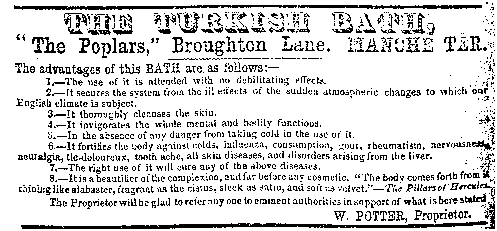
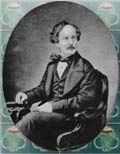

Named for the stories of overseas travellers encountering the traditional Hammams of Turkey, Turkish Baths were highly and exotically decorated and new developments in the manufacture of ceramics, majolica tiles and glazed brickwork coincided well with this trend. Some glazing manufacturers were known to provide their wares at a lower cost in order to "showcase" their designs to the more fashionable and wealthy bathers; in a day when advertising was still in its infancy - and often couched in flowery language with much quotation and allusion to classical works having little to do with the product itself - actually seeing the items in situ was a novelty and was often met with some degree of success.
Over six hundred Turkish baths have so far been identified as once having existed in the British Isles, but these days less than twenty remain, and of this still diminishing number it is believed that less than half were built during Queen Victoria's reign. However, one or two still perform their original function as public baths, and many of the architectural features still remain, although sadly now somewhat worn and shabby at times.
The features which distinguish the British Victorian Turkish bath from those found in other countries are actually not Turkish but more like a re-invention of the Roman bath. It is the dryness of the air which distinguishes the British Victorian Turkish bath from other related types - the vapour bath, the Russian steam bath, the Finnish sauna (in which water is periodically ladled on to the stove / heat source so as to dampen an otherwise dry atmosphere) & from the hammams which are still to be found in Turkey today.
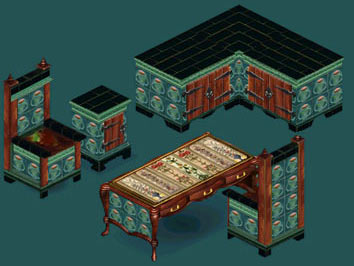
 The Ladies' Baths set 1
The Ladies' Baths set 1
Chair, desk, side table, counter. The side table has been recoloured from an original by Secret Sims.
2015 update: Gender door coding added by The Secret Society of Woobsha
On Bathing. From "The Lady's Dressing Room", by Baroness Staffe, trans. Lady Colin Campbell, 1893
Regular bathing should enter into the habits of all classes of society. If it is absolutely impossible to immerse oneself completely every day in a large bath, or if it is forbidden by the doctor, a sponge-bath may be considered sufficient for the needs of cleanliness and health.
The human skin is a complicated network, whose meshes it is necessary to keep free and open, so that the body may be enabled through them to eliminate the internal impurities, from which it is bound to free itself, under pain of sickness, suffering, and possible death.
The healthy action of the pores of the skin is stimulated by the bath, especially if it is followed by friction with a flesh-glove or a rough towel. One can dispense with massage if one objects to being manipulated by a strange hand. Both fevers and contagious maladies of many kinds are often avoided by such simple precautions as these.
In cases of internal inflammation and congestion, and of bilious colic, there is no more certain remedy than a hot bath. It is also known to have worked surprising cures in cases of obstinate constipation. Anyone who is afraid of having caught a contagious malady should immediately have recourse to a hot bath, as it is quite possible that the infection may make its way out of the body through the pores. Of course, particular care would be needed not to take a chill on leaving the bath.
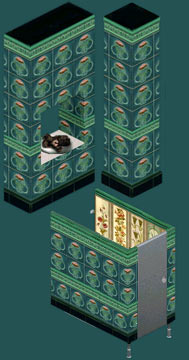
 The Ladies' Baths set 2
The Ladies' Baths set 2
Ladies' fireplace, column & privacy toilet
2015 update: Gender door coding added by The Secret Society of Woobsha
I am privileged to present animated open fireplaces for your Turkish baths, which will not put your sims or their home in any danger. It has cleverly and thoughtfully been cloned from the Tiki Torch, and has been recoloured with kind permission from Cristina at Sims Interior Designs. Your sims can use the loo in complete privacy, no matter who else is in the bathroom at the time. This may require the "Potty Pack" from the official site.
As you can see from the excerpt from "The Lady's Dressing Room" above, Baroness Staffe implies with authority that not bathing regularly could cause "possible death". It is not that she was severely misinformed or indeed attempting to alarm her readers unduly. Little was actually known in those times about the causes of disease or how to cure them - but it had been recognised that those who kept to poor hygiene often suffered from worse health than those who practised cleanliness, and the connection was naturally made.
But cleanliness was a relative term. There were no proper sewage systems in the towns and drinking water was often polluted. Periodic epidemics of cholera and typhoid caused thousands of deaths. People living in damp, unheated houses often died from tuberculosis.
Children also died from diphtheria, scarlet fever, smallpox, measles and whooping cough. Infant mortality was high, and it was the rare family that didn't lose at least one child to diseases that today, thanks to modern sanitary engineering, hygiene practices & medicine, are rare - or we can now view as being little more serious than a common cold.
Until the general acceptance of the germ theory of disease in the later nineteenth century, fevers and epidemics were explained by "miasmas" - exhalations from decaying sewage which poisoned the air. The particularly hot summer of 1858 was known as "The Great Stink of London". Such was the overpowering smell from the Thames that the curtains of the House of Commons were soaked in chloride of lime (an early disinfectant) in an attempt to protect the health of the Members of Parliament.

The decision was urgently taken to provide money to construct a massive new sewer scheme for London and to build the Embankment along the Thames in order to improve the flow of water and river traffic. Sir Joseph William Bazalgette, as Chief Engineer to the newly-formed Metropolitan Board of Works was made responsible for a series of massive public engineering projects that have shaped today's London.
As well as a monumental sewerage system and huge state-of-the-art pumping stations to service it, his works include the Victoria, Albert and Chelsea Embankments of the River Thames, twelve bridges (three of which were to his own designs), street improvements including communications between London’s new railway stations, artisans’ housing, and flood prevention for 40 miles of river frontage.
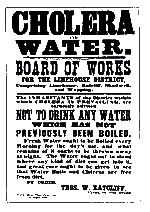
This is how Bazalgette graphically described the "Great Stink of 1858" :
"...the whole of the sewage passed down sewers from the high ground at right angles to the Thames into the low grounds adjoining the Thames, where at high water it was pent up in the sewers, forming great elongated cesspools of stagnant sewage, and then when the tide went down and opened the outlets, that sewage was poured into the river at low water at a time when there was very little water in the river. Furthermore, this sewage kept oscillating up and down the river, while more filth was continually adding to it, until the Thames became absolutely pestilential".
Amazingly, and in complete opposition to anything the "miasma theory" put forward, there was actually no mass outbreak of Cholera or other disease in London that summer.
This was a significant clue picked up by just one man, Dr. John Snow, who spent many years fighting much scepticism to prove conclusively that the miasma theory was wrong and that Cholera was a water-borne disease which could be mostly combatted by simply boiling the water for a specific period of time before using it.
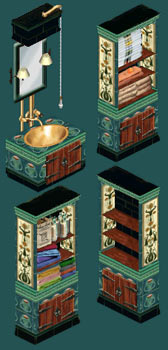
 The Ladies' Baths set 3
The Ladies' Baths set 3
Sink, three shelving units
2015 update: Gender door coding added by The Secret Society of Woobsha, and the Read a Book option is now available on on the shelving units on all lots.
One of the ladies' shelf units comes with some lovely soft Turkish towels & soap, another with more soft towels and various unguents, and the final one is empty. Your sims may even find a book or two in there somewhere. The sink unit has been recoloured from the beautiful original one in the Tombstone set by Secret Sims.
Privies And Cesspools. From "Sanitary Ramblings, Being Sketches and Illustrations of Bethnal Green", by Hector Gavin, 1848.
"The deficient number of privies in the poorer quarters of towns, and the large number of inhabitants resorting to them, deprives them of any right to be considered private, and render it absolutely necessary for the safety of the public health, that some alteration should be made in the law regarding them."- (Second Rep. Com. Health of Towns.)
It is scarcely possible to conceive the utter degradation of the human mind which permits it, at least, to tolerate the disgusting offensiveness of these abominable nuisances, which exist in the form of common privies, in the poorer neighbourhoods. One open necessary for numerous families, and for 20, 30, or 50 persons, is surely most objectionable, but it is quite a common occurrence. It is true that Bethnal-green is not so bad as Sunderland, where there is only one necessary for every 76 persons, but there is a vast amount of moral degradation entailed upon the inhabitants by their being compelled to make use of such a scanty number of such filthy receptacles.
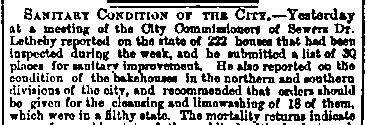
The generality of the privies in this parish are full, and most offensive, great numbers are overflowing. The cesspools attached are, in the majority of instances, in no better condition. Many of the privies are wooden sheds erected over holes from which a surface hollow conducts off the fluid refuse to some other part of the ground. Many are most dilapidated, and some are dangerous to make use of.
In numerous instances the soil (the contents of the privy) has infiltrated the walls, and spread itself over the surface of the neighbouring yard.
The soil has likewise percolated through the walls, and into the houses, and in some instances, the floors have been saturated, and have been rendered very quagmires of filth; the flooring, in such cases, has become rotten. In other instances, the inhabitants have piled either in their yards, or in their houses, or in the alleys fronting the houses, collections of dust and cinders, to conceal from the eye the soil which has oozed from the neighbouring privies or cesspools.The landlords of the poorer tenements very rarely remove the contents of the cesspools or privies, and often neglect to do so, till compelled by the devastations which the exhalations from the soil produce, in the form of fever, alarmed lest their property should get a bad name, and be thus rendered untenantable.
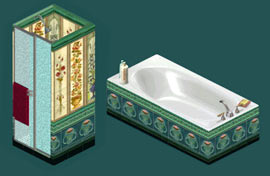
 The Ladies' Baths set 4
The Ladies' Baths set 4
Hacked Shower, Hacked Bathtub
2015 update: Gender door coding added by The Secret Society of Woobsha
The shower and tub design may not be that authentic, but I am sure your sims won't mind - especially as these have been hacked to the maximum energy and hygiene, edited for visitors AND come with more songs under the shower! Not only this, but they are properly categorized to appear as shower/tubs in the buy mode catalogue!
I am proud to present these to you with many grateful thanks to Cambouisfr at C&C Enterprises

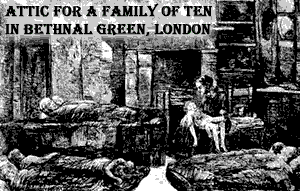
The Registrar General reported in 1841 that while the average life expectancy in Surrey was forty-five years, it was only thirty-seven in London. The average age of "labourers, mechanics, and factory servants" at times of death was only fifteen. Mortality figures for crowded districts like Shoreditch, Whitechapel, and Bermondsey were typically half again or twice as high as those for the more middle-class areas of London.
Chadwick, along with other leading sanitary reformers used the literary techniques of Victorian novelists to create a sense of crisis. Chadwick consulted Dickens over his descriptions of the sanitary conditions of the great towns - and Dickens himself obtained graphic accounts of the vile conditions of reeking graveyards from his brother in law, a leading sanitary reformer. The imaginative force of their writings made people aware of the need for action.
The appearance of Cholera in 1831 provided a more immediate incentive. Water closets were adopted by the more affluent households of London in the early nineteenth century in place of privies and cesspits. As a result, sewers originally intended to take rain water into the Thames now carried raw sewage - which was then extracted by the water companies to be drunk by their customers.
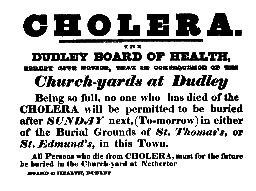
The Metropolitan Commission of Sewers had responsibility but no power to impose sufficient taxes to solve the problem. However, the Public Health Act of 1875 required local authorities to implement building regulations or bye-laws, which insisted that each house should be self-contained with its own sanitation and water.
This change in the design of housing complemented the growing public investment in sewers and water supply. It did little to improve existing housing, but ensured that all new housing from then onwards had adequate provision of sanitation and water of its own.
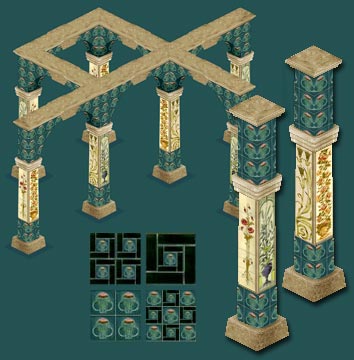
 The Ladies' Baths set 5
The Ladies' Baths set 5
Connecting Arch, three mix 'n' match ceramic tiled walls, four mix 'n' match ceramic and wood panelled walls, four matching floors.
2015 update: Gender door coding added by The Secret Society of Woobsha
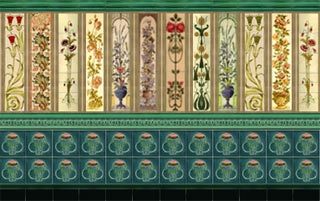
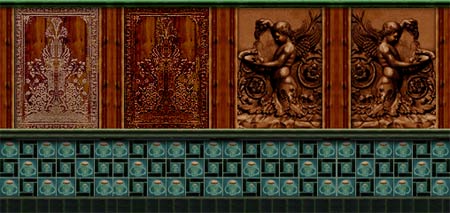
Water Supply. From "Sanitary Ramblings, Being Sketches and Illustrations of Bethnal Green," by Hector Gavin, 1848.
The quantity of water supplied by the East London Water Company is in general good, but in wet weather the water is highly coloured, deposits much sediment, and becomes hard.
The supply is, as usual, three times weekly, for two hours at a time, and is always at low pressure; the great majority of the houses are supplied with water, but, in an immense number of instances, the water is not laid on to the houses, but is supplied by a stand pipe in the yard.
More frequently there is a stand pipe in the street, or alley. Sometimes, there is a stand pipe to two houses, but it is much more common to find a stand pipe supplying every three or four houses. In the courts, and alleys, there is generally only one stand pipe to every 12, 20, or even 30 houses. To many houses there is no water supply whatever, and the inhabitants require to beg or procure it as they best can.
The receptacles to receive the water in the better houses, are generally butts (barrels). There are very few proper cisterns. With the poor, tubs, pails, earthen jugs &c., supply the place of cisterns. A very large proportion of the poorer tenements, those, namely, where there is only one stand pipe to many houses, have no receptacles of any kind, and the inhabitants preserve water in small jugs, open pitchers or wooden vessels, in their houses, or rooms.
Some streets have pumps and sunk tanks communicating with the main. The inhabitants, therefore, have a constant supply, but in a very inconvenient mode. I found three open wooden cisterns common to many houses, the one contained the remains of fish, in a putrescent state; the wood of the second was rotten, covered with green, slimy mould, and the surface of the water iridescent from the scum floating on it; the third was an open kind of horse trough adjacent to a privy.
Some illustrations from The Illustrated Times, new series, iii (1863),. London 1808-1870, The Infernal Wen, Francis Sheppard (1971)
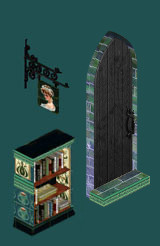
 The Ladies' Baths set 6
The Ladies' Baths set 6
"Ladies Only" door, illuminated "bathing beauty" sign, "at home" magazine rack
2015 update: Gender door coding added by The Secret Society of Woobsha. The step has also been added in front of the door to help guide you when placing the door (the step gets placed outside of the ladies' room). The magazine rack has been tweaked by The Secret Society of Woobsha to be more community-lot friendly: Interest skill ups wont produce pop-ups on away lots anymore unless they are for your selected Sim.
At last a handy place to put your subscription magazines! No more constant trips to the newsstand at $50 a piece! No more well meaning cleaning staff and roommates throwing your hard earned simoleans away before you were through with them! Gone are the days when your periodicals turned to garbage in your hands! Even the kids will have tons of interesting topics to discuss. Place one of these in your house and see the difference! Oddly, the advantages of handy storage also seems to affect memory. Sims no longer forget about one subject to learn another and overall uptake of information appears more rapid and fun with the use of our storage system. With C&C Enterprises New Magazine Rack & Shelves don't be surprised if convenience translates into memory retention! No EP needed but you MUST read the readme text (or follow the installation instructions at the bottom of this page)
The door will ONLY allow your female sims to enter so be careful where you place it! It is clearly marked in the catalogue to distinguish it from the "Men Only" door. Again, hacked into submission by Cambouisfr at C&C Enterprises!
The Municipal Bath
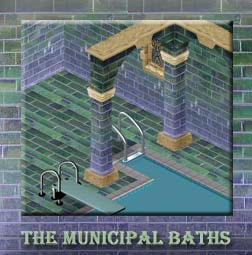
As well as the "miasma theory" detailed above, it was generally believed at this time by most people that any hot humid or moist air was not good for the system and encouraged disease.
In the light of today's medical knowledge, it is perhaps hard to understand the beliefs of a time when the invisible world of bacteria, virii and germs was only just being discovered, but it was widely assumed by the medical establishment that one could become ill or become cured simply by "taking the air" of a different environment.
This belief may well have been fortified by the experiences of overseas travellers to hot, humid countries who, after falling ill with malaria or other insect-borne diseases unknown in Great Britain & not understanding the true origin of the disease blamed instead the obvious difference in ambient weather conditions.
Knowing the weather conditions at any part of the globe at any one time is everyday general knowledge now, but not in Victorian times, and as the climate in Great Britain is very moderate with hardly any extremes of humidity or heat, travelling to "foreign climes" - especially the Far East where high humidity is a way of life - would have made people unused to it very uncomfortable, if not ill, in the first place. Coming home to even a "miasma" would have been beneficial to those who could not take the humidity.
Keeping the air warm but dry in the Turkish Baths was therefore vital in the light of these beliefs, and many new steps forward were made in the development of heaters able to raise and lower air & water to the requisite temperatures and maintain them for sustained periods of time.
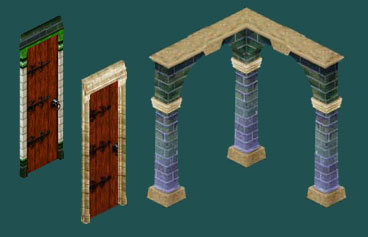
 The Municipal Baths set 1
The Municipal Baths set 1
Connecting arch, outer door, inner general door
The door frames have been retextured using the "no gap" door base from Aenigma Sims - with continuing thanks to her for those wonderful base items.
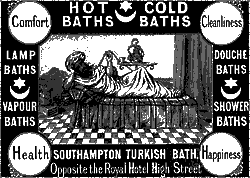
The Victorian Turkish bath starts with the bather sweating freely in a room which is heated by a continuous flow of hot dry air (or in two or three such rooms at progressively higher temperatures), followed by a full body wash (sometimes preceded by a cold plunge), then by a massage, and finally by a period of relaxation in a cooling-room.
These rooms were typically given the Latin names that Roman baths would have used, as part of the trend in using classical literature to give added gravitas to a description. Most of what we now call "networking" by the "movers and shakers" of the day was done inside the more exclusive Turkish baths, and many Gentleman's Clubs built their own private Turkish baths for this express purpose. Indeed, they were often used as unofficial meeting places for the "great and the good" of society to discuss topics in a frank and open off the record way, and many important matters of state or business were often fully discussed & finalised by the grandees within the walls of a Turkish bath long before going forward to any boardroom or Parliament.
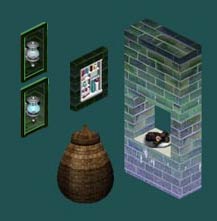
 The Municipal Baths Set 2
The Municipal Baths Set 2
Linen basket, animated fireplace, "miracle cure" medicine cabinet, recessed wall lamp
As before, the animated fireplace will not put your sims or their home in any danger and has been recoloured with kind permission from Cristina at Sims Interior Designs, where you will find this lovely fireplace in a variety of stylish colours and many other fine and unique objects.
A medicine cabinet that really holds medicine...what a concept!
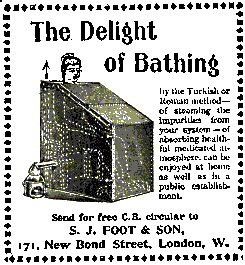
Brush your teeth, practice your public appearance or cure all of the three known Sim Diseases. Effective against LL Guinea Pig Disease, Vacation Poopy Pants and Unleashed Mystery Ailment.
Has the added advantage of cross-vector antimicrobial action that spreads throughout the lot where located - all thanks to C&C Enterprises answering Sim needs with tomorrow's technology today! This cabinet is edited to appear in all lots, since you don't know where diseases will strike. If you are missing an EP just uncategorize it first. It's really easy, see how here.
The linen basket may require the Double Deluxe downloads from the official site, and the recessed wall lamp (shown here both on and off) has been recoloured from an original by Simzalabim.
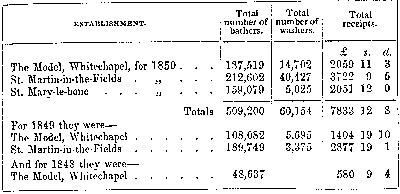
Listings for Turkish Baths from Mogg's New Picture of London and Visitor's Guide to its Sights, 1844
BATHS. Those who luxuriate in bathing will find ample means for their gratification in the various baths with which the metropolis abounds; of which, after a statement of the usual charges, a catalogue is subjoined.
List of prices: - Cold bath, 1s.; warm bath, 3s. 6d.; sea water, 3s.6d.; warm sea water, 7s. 6d.
Out of the many, those notable for their variations include: Chapel Place, Oxford Street, shower and warm; Coram Street, warm and cold; George Street, Adelphi, sea water; Great Marlborough Street, chlorine, vapour, and warm, or hot air; Harley Street, warm and shower; Hewitt's Old Hummums, Covent Garden; Leicester Square, warm, vapour, salt, cold, and shower; Lothbury, Founder's Court, shampooing, vapour, hot air, sea water, &c.; New Road, near Fitzroy Square, cold, warm, and shower; St. Mary Axe, warm and cold; Strand Lane, near Somerset House, cold.
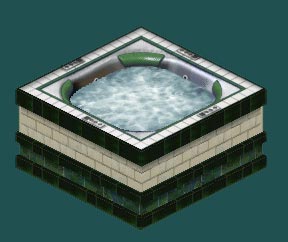
 The Municipal Baths Set 3
The Municipal Baths Set 3
Hot Tub
Minor fix - very outgoing children will now wear their swimsuits.
Hot Date hot tub looking remarkably like the Superstar Hot tub! I preferred this shape & design as it went more with the general feel of this theme than the normal Hot Date tub. Hacked so that kids can use it and sims gain some energy as well as more comfort and hygiene. I am proud to present this lovely item to you with many grateful thanks to Cambouisfr at C&C Enterprises
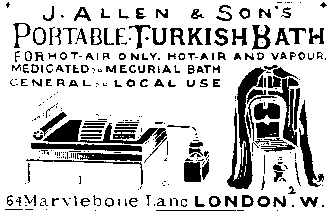
J. ALLEN & SON'S PORTABLE TURKISH BATH - FOR HOT AIR ONLY, HOT-AIR AND VAPOUR, MEDICATED OR MECURIAL BATH, GENERAL OR LOCAL USE
Recommended by the British Medical Journal, Medical Time, Sanitary Record, &c. The Lancet, Feb.23, 1878 - "This instrument is very complete and probably as good a form as can be devised for either a Turkish Bath or a Vapour Bath in a domestic way. What gives great additional value to it is that every precaution has been taken to make an accident impossible. It is portable, and can be packed in a box less that 12 inches square. It is cheap, and it acts promptly."
Complete Apparatus, for use under Chair, with best Cloak .. 42/-
Complete Apparatus, for use under Chair with best Cloak, and tinned Iron Supports, in Box .. 50/-
Complete Apparatus with Wicker Frames for Bed .. 45/- Vide Catalogue for 3 stamps.

 The Municipal Baths Set 4 (UL+)
The Municipal Baths Set 4 (UL+)
Advertising poster set, two large ferns in pots.
Updated 2015: Fixed the flickering caused when a Sim walked behind the semi-transparent posters. This was caused by a change in the game's rendering starting with the Unleashed expansion. The fix, however, may cause the semi-transparent glass to become opaque in earlier (pre-UL) versions of the game. If you find your are having that trouble, the original files should be installed in those games instead.
The six posters are reversible - that is, the words can be read at both rotations. They are not backless, but are virtually invisible from the back view - almost ghostly in appearance. The ferns will never need watering.
One of the posters is for a rheumatism & neuralgia linctus, proudly exclaiming "Where's the Man that we can't cure".
Having read some of the medical accounts and beliefs of the age, it will be no wonder to learn that the Victorians were often taken in by the many "patent" medicines that abounded during this era. Many of these medicines (normally drinkable syrups or linctuses) claimed to be the ultimate "cure all" for every known infirmity. In many instances, you could find a single medicine which would claim to cure rheumatism, pneumonia, diphtheria, sore throats, inflammation of the lungs and kidneys, colds, coughs, influenza, loss of voice, whooping cough and many more ailments. Note the arbitrary mixture of serious and minor ailments in that list.
Selling of such wonder elixirs was especially widespread in the early part of the century in America, where it was easy for an itinerant salesperson to move from one town to another in anonymity when his wares were proved ineffective. They would often have an assistant who would go ahead to a town to hand out advertising flyers a few days before arriving, so their wares would be familiar before they set up their stalls. The same assistant would often pose as a person "miraculously cured" by the elixir.
Later in the century, patent medicine manufacturers issued colourful Trade Cards in much the same manner. They grew to be very popular not only in America, but in Europe as well and the trend lasted for many years. Now highly collectible, they typically had an elaborate picture on one side (six of which are reproduced above as posters for your sims) and "information" about the product on the other. I use inverted commas around the word "information" with good reason.
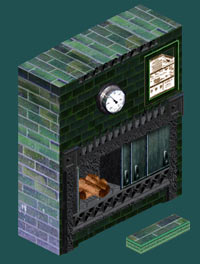
 The Municipal Baths Set 5
The Municipal Baths Set 5
Boilerhouse, false step
The "boilerhouse" is actually a recolour of the lovely ultra-modern Vacation fireplace at Simzalabim and the false step is based on the cloneable one tile rug at Sim Freaks, with many ongoing thanks to the creators of the originals for allowing recolours.
It was important for the makers of these medicines to solicit the faith of the would-be purchasers. Many adverts featured children, promoted fear or gave spurious testimonials such as the one below from an English newspaper for a device called "The Electropoise" which claimed persuasively by a personal account that placing the machine on your head would enable you to rapidly absorb oxygen which in turn would drive out all disease.
Some of the Patent Medicines were actually dangerous. Most were typically made from a "secret formula" which, in reality, meant that they frequently contained alcohol, morphine, cocaine or opiates - sometimes combined.
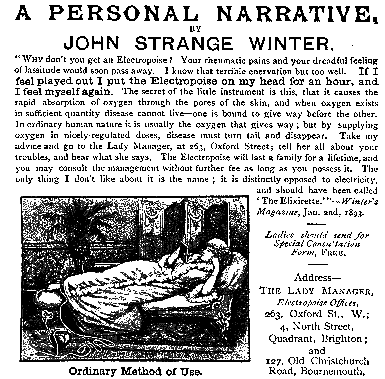
Not all of them were so dangerous; some were simply little more than sugar syrup and fish oil, and some were genuine (though less potent than those offered by a chemist) using medicinal herbs, berries, roots, and bark. This made the job of telling which elixir was going to work and which was going to make matters worse a very difficult task indeed for the Victorian consumer, especially when some of the more dangerous ones would taste better and make a patient feel better than a medicinal one.
One of my posters is for "Mrs. Winslow's Soothing Syrup". This type of medicine was advertised to calm teething babies and to help reduce the swelling of their gums; however, the high morphine content found in this type of medicine could be potentially more harmful to the child than the condition it was taken for.
Another poster advertises "Ayers Cherry Pectoral". This medicine claimed to cure colds, coughs, and all diseases of the throat and lungs; "pectoral" being a term used to describe diseases of the chest. "Ayers Cherry Pectoral" was sure to make the Victorian consumer feel something rather different to their illness since one of the ingredients was, apparently, heroin.
Another card gave a very strong implication that "Scott's Emulsion" was the only thing between an infant and potential death. "Our Boy is a perfect type of health and beauty. It is a delight to look upon such a beautiful picture; but how sad to behold the suffering of the mother when her darling is smitten with disease, and his rounded dimpled cheeks, become pale and wan, and the bright eyes lustreless, and she sees day by day her little one wasting away. Unfortunately in every household some of the little ones are the victims of wasting disorder. For some reason their food fails to nourish them, and they finally fade and die." The card goes on in this way to offer "Scott's Emulsion of Cod Liver Oil" as a marvellous remedy to this "wasting disorder".
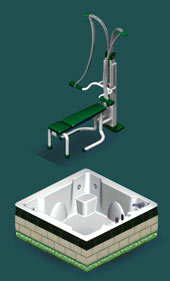
 The Municipal Baths Set 6
The Municipal Baths Set 6
Repaired Hydrotub uploaded - August, 2015
Le Machina now works as a skill object on away lots (As with all skill objects, any skills gained on a DT lot will be lost when you return home). - September, 2015
Hydrotub, "Le Machina" happy workout
The Hydrotub is from the Do-It-Yourself section of C&C Enterprises but I am thoroughly ashamed to admit that I did not do-it-myself. Instead, the very kind and generous Cheerful at N99 did-it-herself for me instead (because I'm a wuss) and this hacked tub will now get more comfort and hygiene at a higher speed, give energy too and is edited for visitors!
Regular bench press machines are fine if you have plenty of spare time and like to sweat A LOT. But if you want to impress your friends while chiseling your physique the only thing that will meet your exacting needs is C&C Enterprises “Le Machina”. Not only does it look impressive and expensive, but it's also a great workout! Discreet micro assist motors reduce the workload while providing induced energy fields to stimulate muscle growth at fast speed. This machine is so advanced and so fun to use that even a child could make an impressive showing! Don't be too obvious or your friends and neighbors might just guess what's really going on. No EP needed.
The Gentleman's Bath
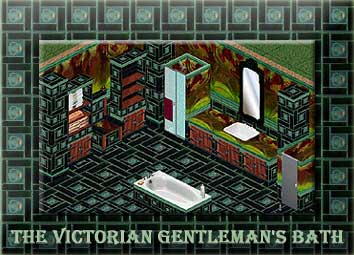
The miasma theory, that cholera was spread from the stink of filth - or as Edwin Chadwick put it, from "epidemic atmosphere" or "deleteriously impregnated air" - while fundamentally flawed, at least moved in the right direction of focusing attention upon filthy conditions, especially inadequate sewerage and accumulations of excrement in public places.
While there were sewers in London, they were woefully inadequate and many houses were not connected to them. In 1847 a report given to the Metropolitan Sewers Commission proclaimed: "There are hundreds, I may say thousands, of houses which have no drainage whatever, and the greater part of them have stinking, overflowing cesspools, and there are hundreds of streets, courts, and alleys, that have no sewers, and how the drainage and filth is cleared away, and how the poor miserable inhabitants live in such a place is hard to tell.
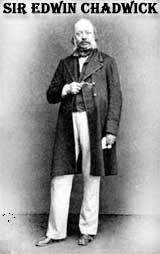

Reports such as those by Sir Edwin Chadwick, John Snow, Hector Gavin and many others did much to improve public and governmental awareness of such squalor.
In 1832 Parliament agreed to an official inquiry into the operation of the Poor Laws. Chadwick's work in establishing the links between poverty and disease resulted in new Poor Laws in 1834. Yet these still did not go far enough and continued work resulted in the Public Health Act of 1848, which set up local health boards, investigated sanitary conditions nationwide, and established a General Board of Health.
John Simon, who replaced Chadwick to become chief medical officer to the General Board of Health, successfully diverted public funds into the investigation of communicable diseases - including diphtheria, typhoid and smallpox - and in the 20 years to 1876 oversaw the transition from the state's mere involvement in reform to a state system of medicine. Having gained some political influence, he found he was able to influence new health legislation. The 1875 Public Health Act comprehensively addressed unsanitary housing, general sewage and drainage, water supply & contagious diseases and provided Britain with the most extensive public health system in the world.

Prevention of disease had come a long way, and alongside this, major improvements in the supply of water occurred throughout the 19th Century. First the development of steam pumping engines enabled water pressure to be increased, followed by the introduction of cast iron water mains. For the first time water had sufficient pressure to be piped to a gravity tank in the attics of houses, allowing plumbed-in bathroom fittings.
Sir Joseph Bazalgette finally had his sewerage system under way - two huge pumping stations serving 82 miles of huge oval brick-lined tunnels linked with over 1,000 miles of street sewers to provide an underground network beneath London's city streets - a task made particularly difficult by his need to compete with the new underground railway, a network of roads and overland railway systems.

As well as developing major sewerage & draining systems, the government also provided significant funds for sanitary research and engineering. With this new incentive, pottery makers including Josiah Wedgewood, Thomas Twyford and John Shanks began to team with inventors as they replaced wood, brass and metalwork normally used in sanitary products with more hygienic and durable ceramic parts. This led to the development of the single most important piece of engineering in the whole history of sanitation; the one single item that has most profoundly affected modern civilization and facilitated large numbers of people living in densely populated towns and cities safely and hygienically - the humble one piece trapless ceramic flush toilet.
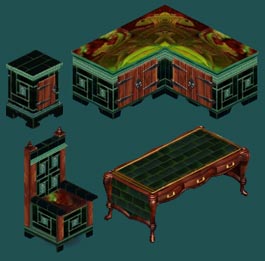
 The Gentlemans' Baths set 1
The Gentlemans' Baths set 1
Chair, desk, side table, counter. The side table has been recoloured from an original by Secret Sims.
2015 update: Gender door coding added by The Secret Society of Woobsha
Because the patent offices of England and the United States have maintained several hundred years of records, the inventors of lavatory (a term used until fairly recently for both sanitary and washing) equipment are fairly well documented. Credit for the invention of the toilet is usually bestowed on Sir John Harington as far back as 1596. He may have had the idea, but making it function was simply not possible with the technology available at the time.
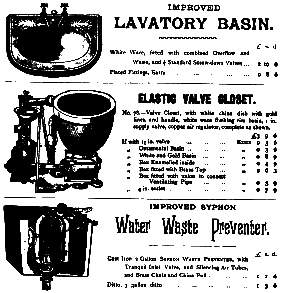
In 1775, Alexander Cummings received an English patent for putting a"S" trap under a bowl. It had a sliding valve underneath to hold the water. This was a major advancement towards a true functioning toilet, yet nothing changed in the general market. This would stay the same until iron foundries improved cast iron pipe and potteries improved terracotta pipe in the 1800s.
The most efficient first generation toilet was a simple bowl with a hole in the front or back and a "P" trap beneath filled with water. These were known as "wash-out" water closets. Several companies in England were selling them as early as the 1870s.
Thomas Twyford revolutionized the water closet business in 1885 when he built the first trapless toilet in a one-piece, all china design - the most hygienic available to this day. English historians credit the Beaufort Works pottery in Chelsea as the first to develop a toilet with a flush tube to the bottom of the bowl in 1886, although an American had received a patent in America 10 years earlier for a similar concept - but could not make it function with the materials available at the time.
The American sanitary industry was said to have been born when pottery maker and designer Thomas Maddock teamed up with William Leigh. Maddock carefully stamped each of his creations with a lion, a unicorn and the inscription: "Best Earthenware Made For the American Market".
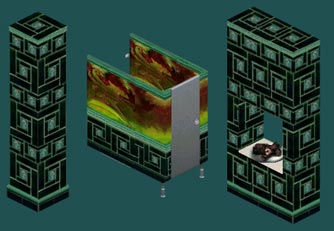
 The Gentlemans' Baths set 2
The Gentlemans' Baths set 2
Fireplace, column & privacy toilet
2015 update: Gender door coding added by The Secret Society of Woobsha
I am privileged to present animated open fireplaces for your Turkish baths, which will not put your sims or their home in any danger. It has cleverly and thoughtfully been cloned from the Tiki Torch, and has been recoloured with kind permission from Cristina at Sims Interior Designs.
Your sims can use the loo in complete privacy, no matter who else is in the bathroom at the time. This may require the "Potty Pack" from the official site.
The pioneering companies that first brought the toilet to market were more a company of artists than engineers, and mostly came from the same branch of the English ceramic industry involved in tile production and table china. Royal Doulton, a company still known for its fine china, was one of the first and largest makers of wash-out toilets.
They put their names boldly & proudly on the products they created - including sanitary ware. And this now brings us to another urban myth which needs to be debunked - concerning one Thomas Crapper.
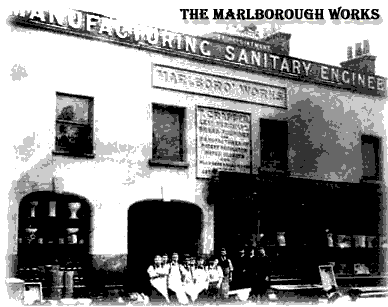
Although Thomas Crapper is rightly associated with the toilet and actually was an innovator and inventor who held nine patents in plumbing, despite popular myth he did not invent the toilet. He championed the "water-waste-preventing cistern syphon", invented the bathroom showroom and displayed his wares in large plate glass windows at the Marlborough Works, and like other artisans, he proudly placed his name on the sanitary ware products he manufactured, but he apparently made no major contribution to the technology or design of today's toilet.
According to Snopes, legend has it that US soldiers stationed in England during World War I (some of whom had little or no experience with indoor plumbing) saw toilets marked with the name "Crapper" and took the word home as a synonym for "bathroom." But why? His were not the only sanitary products they would have seen.
I am not going to digress into a treatise of how much American English can be compared more favourably towards Elizabethan British English than modern-day British English, suffice it to say there are many words in todays American usage which Shakespeare and his contemporaries would understand far more readily than they would today of usage in England.
Some etymologists have proved that the word "crap" as a euphemism for dirt, general waste and human waste predates Victorian plumbing as far back as Elizabethan England - and thus it would have been taken over to the USA by the early settlers. In England the word gradually fell out of common usage, as did many other words and phrases of the age (as all schoolchildren forced to learn the works of Shakespeare will knowingly attest) but not so in America.
Knowing all of this strengthens the case for the theory that Thomas Crapper's name rather than Doulton or other familiar product names caught on as popular US slang because of the prior knowledge and use of the word "crap" combined with the "er" suffix on "Crapper" makes the name strongly resemble a verb, and thus easy (and very tempting!) to adapt as a euphemism for a room and the action concerning a waste product with his name boldly printed on.
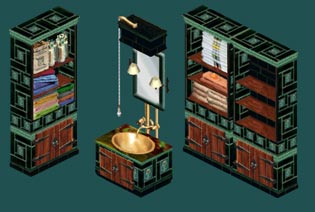
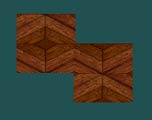
 The Gentlemans' Baths set 3
The Gentlemans' Baths set 3
Sink, three shelving units, three mix 'n' match ceramic tiled walls, three mix 'n' match wood panelled walls, two wood parquet floors.
2015 update: Gender door coding added by The Secret Society of Woobsha, and the Read a Book option is now available on on the shelving units on all lots.
One of the shelf units comes with some lovely soft Turkish towels & soap, another with more soft towels and various unguents, and the final one is empty. Your sims may even find a book or two in there somewhere.
The sink unit has been recoloured from the beautiful original one in the Tombstone set by Secret Sims.
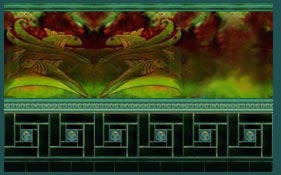
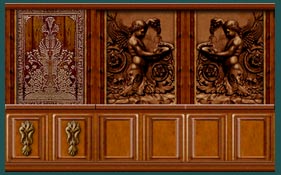


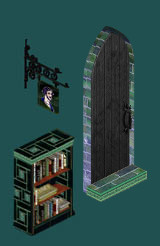
 The Gentlemans' Baths set 4
The Gentlemans' Baths set 4
"Men Only" door, illuminated "Dapper Dandy" sign, "at home" magazine rack
2015 update: Gender door coding added by The Secret Society of Woobsha. The step has also been added in front of the door to help guide you when placing the door (the step gets placed outside of the gents' room). The magazine rack has been tweaked by The Secret Society of Woobsha to be more community-lot friendly: Interest skill ups wont produce pop-ups on away lots anymore unless they are for your selected Sim.
At last a handy place to put your subscription magazines! No more constant trips to the newsstand at $50 a piece! No more well meaning cleaning staff and roommates throwing your hard earned simoleans away before you were through with them! Gone are the days when your periodicals turned to garbage in your hands! Even the kids will have tons of interesting topics to discuss. Place one of these in your house and see the difference!
Oddly, the advantages of handy storage also seems to affect memory. Sims no longer forget about one subject to learn another and overall uptake of information appears more rapid and fun with the use of our storage system. With C&C Enterprises New Magazine Rack & Shelves don't be surprised if convenience translates into memory retention! No EP needed but you MUST follow the installation instructions at the bottom of this page. It will not work otherwise.
The door will ONLY allow your male sims to enter so be careful where you place it! It is clearly marked in the catalogue to distinguish it from the "Ladies Only" door. Again, hacked into submission by Cambouisfr at C&C Enterprises!
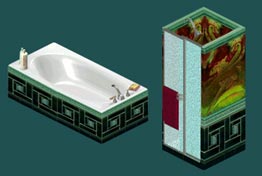
 The Gentlemans' Baths set 5
The Gentlemans' Baths set 5
Hacked Shower, Hacked Bathtub
2015 update: Gender door coding added by The Secret Society of Woobsha
The shower and tub design may not be that authentic, but I am sure your sims won't mind - especially as these have been hacked to the maximum energy and hygiene, edited for visitors AND come with more songs under the shower! Not only this, but they are properly categorized to appear as shower/tubs in the buy mode catalogue!
I am proud to present these to you with many grateful thanks to Cambouisfr at C&C Enterprises
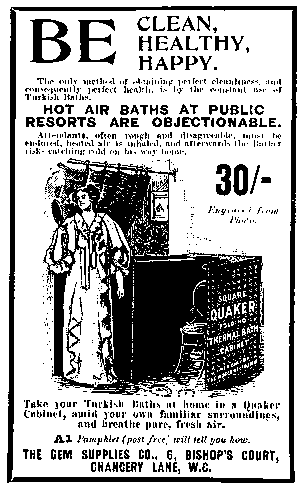
We have learned much about sanitary reform, but the Victorian Turkish bath alone adds to our knowledge of many aspects of Victorian life in England :
- the working men who concerned themselves with their country's foreign policy;
- the use of the bath in Victorian hospitals and asylums;
- the early provision of bathing facilities for women;
- the growing use of advertising to both trade and public;
- the mixing of different classes of society within one small & intimate environment;
- contemporary sanitary conditions and people's changing attitudes to cleanliness;
- the esoteric ritual of the Turkish bath itself;
- the wealthy philanthropists who believed in the necessity of providing public facilities for those unable to afford private ones;
- the lavish and exotic architecture and decoration of the buildings;
- the development of heaters able to raise and lower air & water to the requisite temperatures;
- the attitudes of the medical profession to the Turkish bath and its opposing views as either "quackery" or a place as a curative;
- the growing trend towards the provision of sanitary arrangements within private homes;
- the rise of the limited liability company and the founding of the Rochdale Pioneers' Co-operative Movement.
NEW THINGS! - Laundry Add-Ons
Country houses had dedicated laundry maids, sometimes using washing machines, whilst wealthier town residents used laundries, although it is said that the washerwomen who came to collect the dirty linen were notorious spreaders of influenza and scarlet fever. Newly-built terraced houses often shared a wash-house in the backyard.
The washing machine of the 1880s was a far cry from the ones we know today. They were expensive, and even so it took a woman with considerably developed arm muscles to work one all day long. They also had a tendency to tear clothes or leave rust marks. Poorer households used a "tub & dolly" - more of which below.
Increasingly, households used a "copper" for washing. This was a large cast-iron tub built into the corner of a room with a brick surround and space underneath for a fire to be lit to heat the water. Smaller houses had only a wooden tub - sometimes an old barrel from a brewery - or, towards the end of the 19th century, a galvanised zinc tub. Water for these tubs was heated directly on the range.

Made from solid cast iron, the range was at the centre of family life, providing cooking facilities, hot water and heat. It needed regular cleaning and caring for to keep it as efficient as possible, and I recall my grandmother polished (or "black-leaded") our range weekly with what I remember to be a sort of carbon polish which smelled quite foul and got everywhere except where you wanted it to go.
Washing was a long and laborious process, often taking up to a week to complete. "The Girl's Own Paper" of 1899 recommended the following programme:
- Monday - Steeping (soaking)
- Tuesday - Washing
- Wednesday - Folding and Starching
- Thursday - Ironing
- Friday - Airing
In fact, many households would have begun steeping on Saturday evening, with clothes reserved for 'Sunday-best' being worn the next day. Washing itself, the most arduous of tasks, could then take place on Monday when a quick meal of cold meat from the previous day's joint could be prepared.
The first step women took on washing day was to fetch water. More and more large country houses and communal wash-houses in towns were being connected to a water supply, but individual town houses had to rely on the nearest pump. Country people had to draw water from a well in the garden, or even in the village. Most cottages also had a butt for the collection of rainwater - highly prized since it was so soft.

If the available water was hard or otherwise not good for washing, it was treated by boiling it with wood ashes and then straining it. Although one could now purchase soap, in the poorer homes it was still mostly hand made from the basic materials of water, wood ash, and lard. Coal tar and onion skins were two items added to help remove stains. Often, extra lye (an alkaline liquid obtained from the wood ash) was added to make dirt easier to remove. Household manuals contained many recipes for soap, and most but the poorest homes probably had a handful of varieties all used for different purposes.
The Laundry objects are not in the house, nor in its BigZip below - please download these separately!
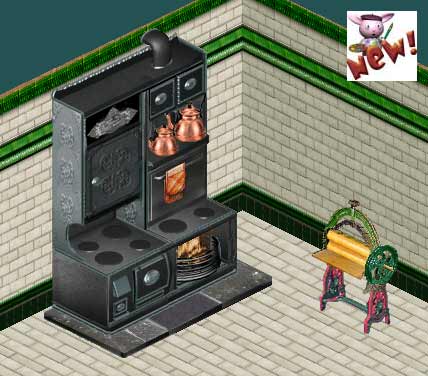
 Cast Iron Range & Mangle
Cast Iron Range & Mangle
REPAIRED 2015 - A GUID conflict was found and in August of 2015 files were re cloned with new GUIDs. This zip was effected by that repair.
The range is a two tiled stove, but unfortunately the fire is not animated. It stands on a Welsh slate hearth to protect your carpets though ;o) The hearth will bleed through walls as it is wider than the tile it sits on so don't put this range in a recess or corner.
The mangle is actually a one-tile dresser, with many thanks to Turbollama for the wonderful cloneable base object!
White laundry went in first as it needed the hottest water. This was removed with wooden tongs and progressively darker items followed. Some white items required boiling, taking anything from half an hour to half a day. The laundry was rinsed three times, and in the final rinse a 'blue bag' (a calico bag with a special blue powder) was added with white items to maintain their original brightness. Blue pigments are still added to today's detergents & washing powders as optical brighteners.
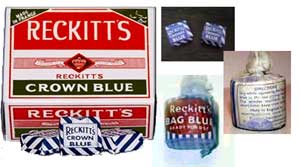
"The Backbarrow Ultramarine Works Company" (later "Reckitts Colours" then "Reckitts Colman" until its closure in 1981) produced dolly or packet blue - an artificial lapis lazuli from a complex of raw materials including bones, china clay, coal tar pitch, coke, feldspar, hydrated iron oxides, silica, soda ash, sodium sulphate, and sulphur. As you can imagine, the factory had a very high chimney! The firm employed 65 people, apparently so covered in blue at the end of the day that those living further away from the works had to have their own bus.
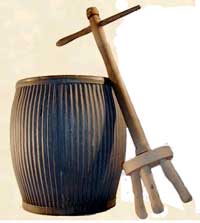
The dirtiest items of washing were scrubbed on a washboard. A more modern and less drastic method of agitating clothes was a “dolly.” This was a wooden stick with wood pins attached to the bottom. The laundress pushed the dolly into the full wash tub, and mustering up all her strength spun it back and forth.
The dolly tub was originally made from wood but galvanised steel became popular because it was lighter and therefore easier to empty. This was important as the dolly tub needed to be filled and emptied many times on washday.
The dolly peg was made from wood and had 3, 4 or even 5 legs. It was turned backwards and forwards in the dolly tub to agitate the clothes and get them clean. Housekeepers said the dolly peg should be turned 100 times for each item of washing!
Tubs & Dollies were used for many years; my own mother recalls using one while in pre-war service, and I recall that my grandmother still had her original wedding present one - though by the 1960s she had long abandoned using it for washing and had it filled with plants instead. Her old mangle looked very attractive sat among the plantpots too.
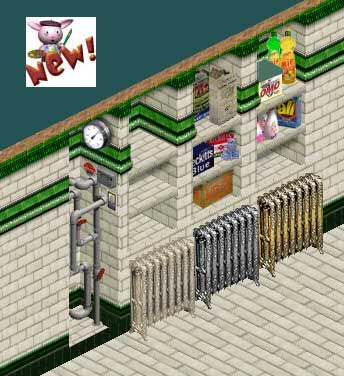
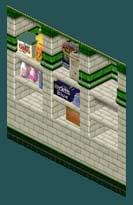
 Recessed Shelving & Radiators
Recessed Shelving & Radiators
REPAIRED 2015 - A GUID conflict was found and in August of 2015 files were re cloned with new GUIDs. This zip was effected by that repair.
Three sets of recessed shelves all based on a backless reversible one tiled painting base, three radiators based on a one-tiled rug piece and one recessed control panel for the boiler room.
With many many thanks to Koromo from Persimmon Grove for allowing me to use the pipework graphic, and Sandy from Around The Sims for allowing me to use some of her detergent graphics in the modern shelf unit. The centre shelf unit features some vintage soap and laundry products for your vintage homes!
The radiators come in three finishes - galvanised iron, brass plated and painted cream. I worked hard on the Z buffers so you can put them against walls which have things on (or windows in) AND still place smaller items on the same tile.
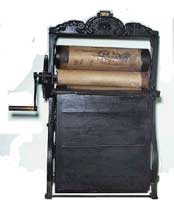
After the final rinse, excess water was wrung out to speed drying time. Early in the 19th century, most women had to wring their clothes out by hand. Larger items were wrung out by two laundresses twisting the garment or sheet at either end several times, the last time occasionally inbetween two towels to soak up every last drop possible. By mid–century, wringing machines - or mangles - were used instead. To get as much water out of the garment as possible, it was folded neatly and then fed between the wringer’s two rollers (usually made of wood and later covered with rubber) while a hand crank was turned to squeeze out any excess water. The name "mangle" gained a new definition because if the laundress was not careful, the garment would get caught in the mechanism of the rollers, "mangling", staining or even tearing the item. If she lost concentration, she could easily get her apron, fingers or hands caught too as she had to stand at the side of the machine feeding and extracting the item from the rollers with one hand while turning the crank with the other.
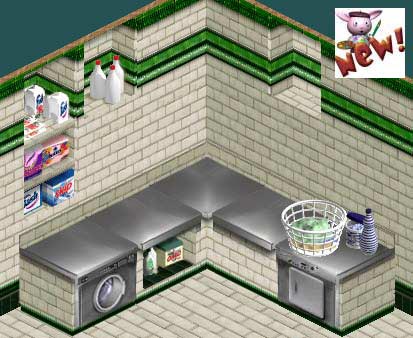
 Modern washing day kit
Modern washing day kit
REPAIRED 2015 - A GUID conflict was found and in August of 2015 files were re cloned with new GUIDs. This zip was effected by that repair.
Animated washing machine - based on the freestanding light column so it need not go against a wall, two counters and a tumble dryer. The dryer is not animated but is cloned from Turbollama's single tile dresser base so your sims can enjoy lovely warm soft clothes straight from the dryer.

The dryer, wall recesses and counter feature graphics from Sandy's lovely laundry set at Around The Sims so they will all match up together for that authentic laundry room experience. I have also included a plain dryer, again cloned from Turbo's one tile dresser base. I am indebted to his generosity - and that of the Coconut Hut members - for allowing his bases to be fileshared and cloned.
I made the wall recesses some time ago and although they are backless, they are not reversible like the previous ones, but I don't think it matters.
Drying the clothes was a long job. The items were set out to dry or hung on the laundry line with wooden pegs, sometimes on a line strung across the street. Pulleys were used on the laundry line upright posts to raise the line as high as possible to keep the newly laundered clothes away from splashes of mud & filth from the unpaved ground. When it rained the laundry was dried indoors in front of the fire, hung over wooden frames known as clothes horses or maidens, or on racks suspended from the ceiling.
"Practical Housekeeping", published in 1884, suggested that "...in the summer, the excessive heat of washing day could be reduced by not lighting a fire and soaking the clothes overnight in soapy soft water, rubbing out in the morning, soaping the dirty placed, and laying them in the hot sunshine. By the time the last are spread out to bleach, the first may be taken up, washed out and rinsed.” This would not have been possible in cities like London, where most houses had little or no clean yard space to lay out clothes.
A few items, such as caps and men's shirts, needed starching to regain their crispness. Wheat, potatoes and rice were used to produce the necessary starch until commercial manufacture began on a significant scale in the 1840s.
Finally the laundry was pressed using a 'flat iron' or, if it was a larger item, put through the mangle again first. The flat iron was heated on the range but, with no temperature gauge to work with, just imagine the number of items which got scorched! These irons were also a lot smaller than those we use today, and although most had a wooden handle, the heat of the iron meant that the laundress more often than not had to use a cloth to pick it up and use it. And I thought ironing was a chore today.....
Installation Instructions
Unzip to a temporary storage folder, and you must move the files accordingly as below:- House06.iff to C:\Program Files\Maxis\The Sims\UserData\Houses (for the original "The Sims") or C:\Program Files\Maxis\The Sims\UserDataXX\Houses - where XX is the number of the neighborhood. For example, if you want it in Neighborhood 3, it goes to: C:\Program Files\Maxis\The Sims\UserData3\Houses\House06.iff
- Other files ending in .iff to C:\Program Files\Maxis\The Sims\GameData\UserObjects
- Files ending in .wll to C:\Program Files\Maxis\The Sims\GameData\Walls
- Files ending in .flr to C:\Program Files\Maxis\The Sims\GameData\Floors
- Files ending in .cmx to C:\Program Files\Maxis\The Sims\GameData\Skins
- Files ending in .bmp to C:\Program Files\Maxis\The Sims\GameData\Skins
- Files ending in .skn to C:\Program Files\Maxis\The Sims\GameData\Skins
"Can I Clone?"

If you would like to redesign or recolor objects from the Turkish Baths set, please do! So long as you provide credit on your site and in the object description with a link back to Architectural Supplies.
Please, no paysites (unless the item is free and remains free) or sites where to get the item, membership is mandatory and/or restricted (except Yahoo groups and the forums listed on my front page).
Items I have used from other sites have their own terms - see these below.
- Animated Tiki-Torch Fireplaces were recoloured with kind permission from Cristina at Sims Interior Designs Please ask her for permissions to clone them.
- The sinks and other Secret Sims objects can no longer be cloned.
- The Laundry Set at Around The Sims is cloneable!
- All C&C Enterprises items can be cloned!
- All Persimmon Grove items can be cloned including the droppable one-tile rug.
- The Door Bases from Aenigma Sims are cloneable!
- Turbollama's One Tile Dresser base is cloneable!
- Items from Another #%*& Sim Site are all cloneable!
Updates and Changes in 2015
HYDROTUB FIXED!!! and re-uploaded August, 2015September 2015 Fixes:
LADIES AND GENTS ROOMS WORK MORE SMOOTHLY: The furnishings and gender door have all been the coding that allows objects to work with the gender doors. Additionally the bookshelves have been fixed so Read A Book is now available on all lots; the C&C Magazine racks wont pop skillup messages up on away lots, except for your selected sim; The hydrotub has been fixed so it no longer falsely advertises for the bladder motive
COMMON AREAS: The stairwell has been hacked with gno's 2-way hack allowing multiple sims to use the stairs at one time; The Advert posters and Skylight pieces have been updated to prevent flickering in UL+ games when a Sim walks behind them (No or Low EP games may need to use the old files to keep the objects semi-transparent); The Hottub has been fixed so outgoing kids choose a simsuit anyway.
ALL FILES: All objects were also tidied up a bit: (unused thumbnails were removed , a real thumbnail was added, and the objects are now categorized for all lot types. If this causes trouble in your game, remember to de-categorize them appropriately before playing.
Showcase
Want more antique laundry items?
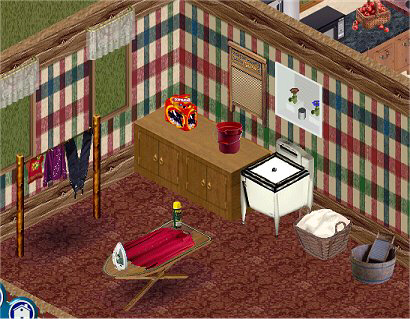
See the lovely Farm set at Hooty Holler
Want more modern laundry items?
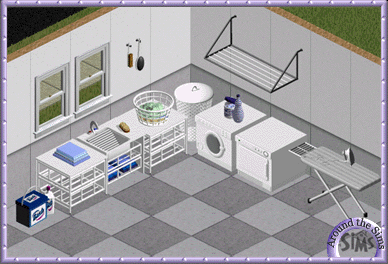
See the lovely Laundry Room set at Around The Sims
Want your pool to really work as a bath?
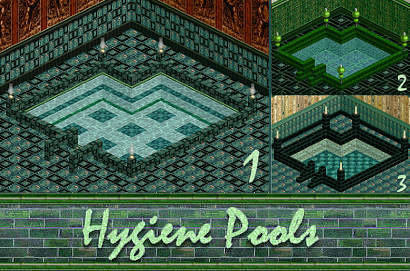
See the lovely Hygiene Pool items at Aponee Simz (Y!Group)
Want matching spa items?
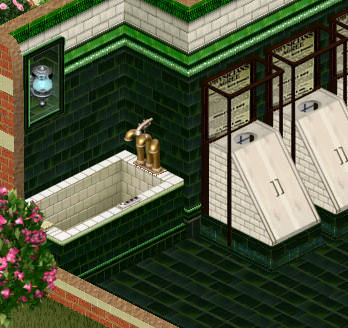
Find some at the Secret Society of Woobsha




